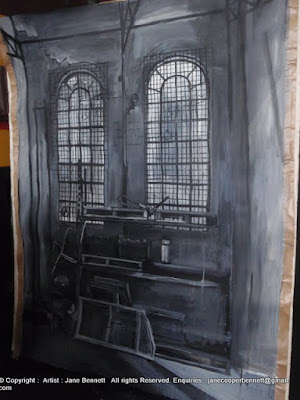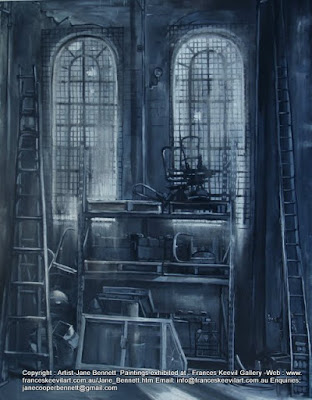A Tale of 2 Prizes
Just returned to Australia from my exhibition in Seoul, South Korea, to find a little box of acrylics, sketch books and other art paraphernalia that had been sitting on my doorstep unnoticed.
As well as winning actual money as 2nd prize at the Royal Easter Show, some kind sponsor had thrown in some art equipment as well.
I could easily go through all the paint in those little tubes in a single afternoon, but all donations gratefully received!
 |
E83 'Blacksmith forging '2011
ink pastel acrylic on paper 9 x 10cm
WINNER 2nd Prize for Miniature Painting
2011 Royal Easter Show
Sold
PRIVATE COLLECTION : SYDNEY
Enquiries : janecooperbennett@gmail.com
When you add the cash amount to the cost of the box of paints, this tiny little painting actually won more than double its price in prize money ! I wish I could keep that standard up for every painting!
|
However, my other equally worthy contenders for prizes got nowhere.
A thorn in my side has been the so-called "Plein Air Painting" Prize. I doubt that I will ever bother entering again.
As I am one of the very few genuine plein air painters in existence, who doesn't just paint small studies but lugs giant canvases around wharves, demolition sites and foundries, to the bemusement of hundreds of surprised wharfies, blacksmiths and demolition contractors, I consider this art prize a farce. The trouble is that after decades of painting swiftly in adverse weather conditions in front of workmen and passers-by, my works just don't have that clumsy slapped together look demanded by the organizers.
My works rarely have much 'studio intervention' other than simple repair work ( bird dirt, insect,twig and dust removal ; and removal of grubby fingerprints from carrying them awkwardly) They have been painted quickly, but as these might well be the only records of a particular event or even an entire location, they have to look as though time were not an issue, or the lack of time an excuse for bad painting. In other words, they have to compete on their merits.
Ironically, the same works entered in the Plein Air Painting Prize (not the ones shown here by the way) had won art prizes elsewhere in which the painting process was not an issue.
Now I've had good works chucked out of countless other art prizes and just laughed about it - I take a philosophical attitude.
The funniest occasion was when my rather nice watercolour of the Spit Bridge got thrown out of the Royal Easter show, and, wanting to get it out of my lounge room, I put it in the Wynne Prize for Landscape for a bit of a laugh. It promptly won the Trustee's Prize for Watercolour and the Pring Prize - the joke was that if it hadn't been chucked out of the Royal Easter Show I would never have thought of entering the Wynne.
In all my years of winning prizes and selling paintings at the Royal Easter Show, getting my painting thrown out was the biggest favour they ever did me!
So why does this particular art prize stick in my throat? Because it is a Plein Air Art Prize.
I have never had a work hung in this particular art prize where I am quite possibly one of its few genuine practitioners. And I probably never will.
I have been told that my works don't have the 'look' of having been painted 'en plein air'. Yet they are. To be regarded as 'credible' my paintings should be messier, more thickly painted, more indecisive,dumber, clumsier, more unfinished, with less ambitious perspective and simpler composition and design. I have paid the penalty for my painting skill.
The works should be smaller as well- this art prize has the strange size restriction of being geared towards vertical work, with a generous vertical height limit of 2m but a horizontal one of only 85cm.
Because "nobody paints large canvases 'en plein air' !"
The predictable result is a bias towards a vertical grid of little studies. Fine, but one of the valid aspects of landscape painting has always been the "sublime"- the feeling of being overawed and overwhelmed, even physically threatened by the landscape. In this art prize there is no room for the heroic.
In short you mustn't challenge their preconceptions of what a plein air painting is. And I have no use for work that toes the line and does the 'expected'. I have been punished for my temperament as well as my skill in painting.
I've seen artists (usually amateurs) paint outdoors in parks, gardens or the rural environment. But in all my decades of painting I have never seen anyone except Tom Carment tackle the urban environment we all mostly actually live in, 'en plein air'. I can't help feeling that artists indulge in escapism by going off for expensive weekend retreats to the bush for 'inspiration' instead of noticing the hidden beauty closer to home.
So today I will take my unloved and unbelieved paintings from the art gallery loading dock, back to the wharf, construction site or foundry where they were created. At least the truck-drivers, wharfies and security guards who watched me paint them, know how to appreciate them.
And they certainly do.
These works have now all been sold.
 |
E53 The Blacksmith Bay 1 Eveleigh
|



















